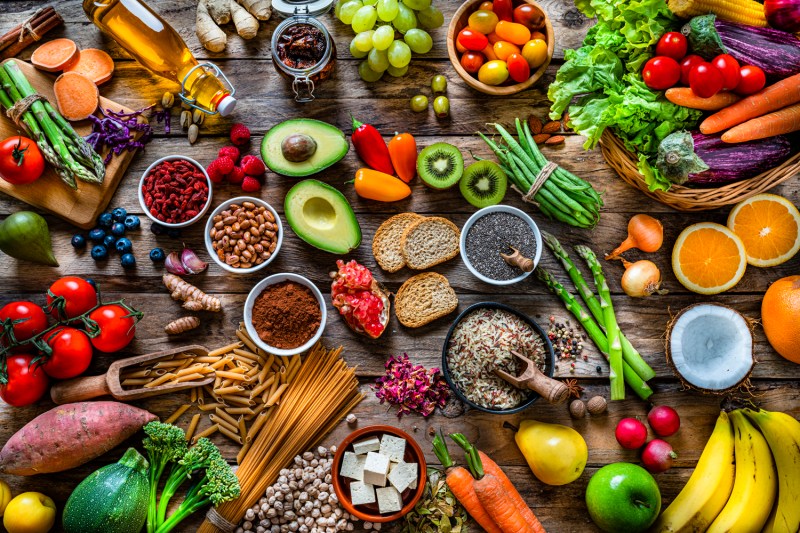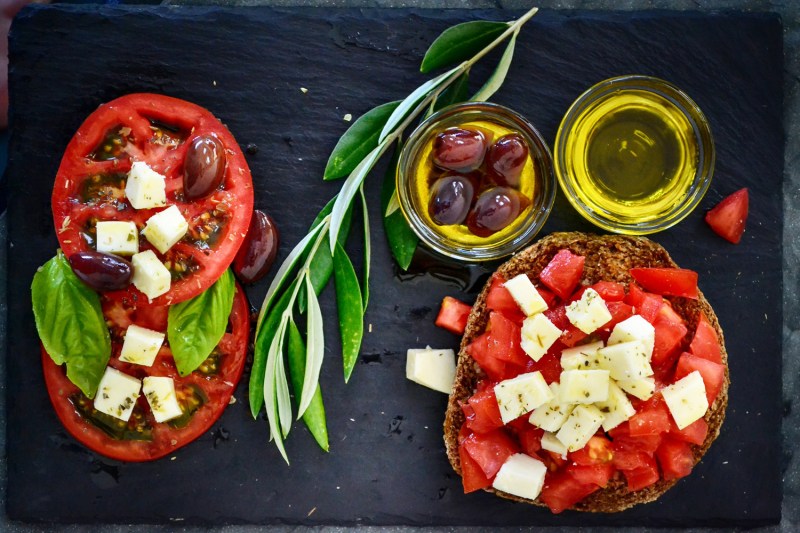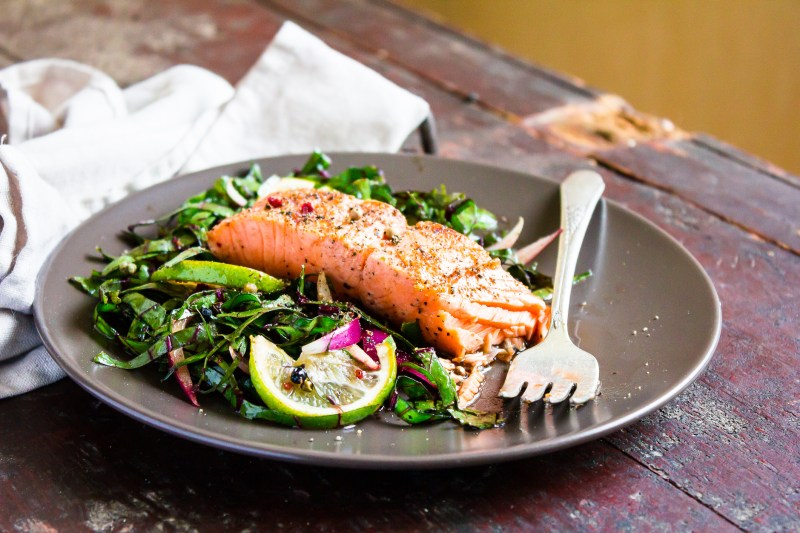Known for its heart-healthy benefits and delicious flavors, the Mediterranean diet emphasizes whole foods, healthy fats, and plenty of fruits and vegetables. It’s easy to have a salad with a drizzle of olive oil for lunch or grilled salmon and whole-grain pasta for dinner, but what do you do for breakfast on the Mediterranean diet?
Whether you’re new to this way of eating or looking to expand your breakfast repertoire, these seven easy
7 delicious Mediterranean breakfast recipes to try

Greek yogurt with honey and nuts
This is a simple yet satisfying Mediterranean diet breakfast. For more flavor and nutrients, you can add mixed berries before the honey.
Ingredients:
- 1 cup Greek yogurt
- 1 tablespoon honey
- 2 tablespoons mixed nuts (almonds, walnuts, pistachios)
Method:
- Spoon the Greek yogurt into a bowl.
- Drizzle honey over the top.
- Sprinkle with mixed nuts.
- Serve immediately.
Avocado toast with tomatoes and feta
A modern twist on a classic, this avocado toast is topped with juicy tomatoes and tangy feta cheese.
Ingredients:
- 1 slice whole-grain bread
- 1/2 avocado, mashed
- 1/4 cup cherry tomatoes, halved
- 1 tablespoon crumbled feta cheese
- Salt and pepper to taste
Method:
- Toast the bread to your liking.
- Spread the mashed avocado on the toast.
- Top with cherry tomatoes and feta cheese.
- Season with salt and pepper.
- Serve immediately.
Spinach and feta omelet
This dish is a protein-packed omelet filled with fresh spinach and creamy feta cheese.
Ingredients:
- 2 eggs
- 1/2 cup fresh spinach, chopped
- 1/4 cup crumbled feta cheese
- 1 tablespoon olive oil
- Salt and pepper to taste
Method:
- Beat the eggs in a bowl and season with salt and pepper.
- Heat olive oil in a pan over medium heat.
- Add spinach and cook until wilted.
- Pour in the eggs and cook. As they begin to set, lift the eggs’ edges and ensure oil runs under them. This will help you fold it and lift it out of the pan.
- Sprinkle feta cheese on one half of the omelet. (Some people might prefer adding the spinach at this step, so it’s inside the omelet instead of outside.)
- Fold the omelet in half and serve.
Mediterranean breakfast bowl
This is a hearty bowl filled with quinoa, vegetables, and a poached egg. You can mix up the vegetables depending on what’s available and what you like.
Ingredients:
- 1/2 cup quinoa
- 1/4 cup cherry tomatoes, halved
- 1/4 cup cucumber, diced
- 1/4 cup Kalamata olives, sliced
- 1 egg
- 1 tablespoon olive oil
- Salt and pepper to taste
Method:
- Simmer the quinoa in one cup of water for about 15 minutes or until the water is absorbed.
- Crack the egg, drop it into the simmering water, and cook for 3-4 minutes, until the white is set but the yolk is still runny.
- While the egg is cooking, combine quinoa, tomatoes, cucumber, and olives in a bowl.
- Drizzle with olive oil and season with salt and pepper.
- Remove the egg from the water with a slotted spoon and place it on top of the bowl.
- Serve immediately.
Whole-grain pancakes with fresh berries
These fluffy pancakes are made with whole-grain flour and topped with a mix of fresh berries.
Ingredients:
- 1 cup whole-grain flour
- 1 tablespoon baking powder
- 1 cup milk
- 1 egg
- 1 tablespoon olive oil
- 1 cup mixed fresh berries
Method:
- In a bowl, mix flour and baking powder.
- In another bowl, whisk milk, egg, and olive oil.
- Pour dry ingredients into wet, and mix until smooth.
- Heat a pan over medium heat and pour batter to form pancakes.
- Cook until bubbles form, then flip and cook until golden.
- Serve with fresh berries on top.
Smoked salmon and avocado bagel
It’s a must to try this delicious bagel recipe topped with smoked salmon, avocado, and a sprinkle of dill.
Ingredients:
- 1 whole-grain bagel, halved
- 2 ounces smoked salmon
- 1/2 avocado, sliced
- Fresh dill for garnish
- Lemon juice, to taste
Method:
- Toast the bagel halves.
- Layer smoked salmon and avocado slices on each half.
- Garnish with fresh dill and a squeeze of lemon juice.
- Serve immediately.
Mediterranean fruit salad
This simple breakfast is a refreshing mix of fruits with mint and honey.
Ingredients:
- 1 cup watermelon, cubed
- 1 cup cantaloupe, cubed
- 1 cup grapes, halved
- 1 tablespoon fresh mint, chopped
- 1 tablespoon honey
Method:
- Combine watermelon, cantaloupe, and grapes in a bowl.
- Sprinkle with fresh mint.
- Drizzle with honey.
- Toss gently and serve.
What is the Mediterranean diet?

The Mediterranean diet is inspired by the traditional diets of countries bordering the Mediterranean Sea, like Greece, Italy, and Spain. It focuses on eating lots of vegetables, fruits, whole grains, legumes, nuts, and seeds.
Olive oil is the primary source of fat, and fish, poultry, and dairy are recommended in moderation, but red meat and sweets are limited. The diet is renowned for its health benefits, including reduced risk of heart disease, improved brain function, and weight loss. Even clinical trials show a reduction in inflammation and obesity.
What ingredients would a Mediterranean breakfast include?

As the
Are there any restrictions with Mediterranean breakfasts?

While the Mediterranean diet is flexible, there are some guidelines. Processed foods, refined sugars, and unhealthy fats are generally avoided. This means steering clear of sugary cereals, pastries, and processed meats. Instead, focus on whole, unprocessed foods, which not only have fewer unhealthy additives but give your gut microbiome that it needs to thrive.
Portion control is also important, as the diet emphasizes quality over quantity. Moderate alcohol consumption, particularly red wine, is part of the Mediterranean lifestyle, but it’s limited and probably shouldn’t be part of breakfast.
Frequently asked questions

Is oatmeal allowed on the Mediterranean diet?
Yes, oats are a whole grain that can make a great contribution to a Mediterranean breakfast. Top oatmeal with fresh fruits, nuts, and a drizzle of honey for a nutritious breakfast.
What do I drink in the morning on a Mediterranean diet?
You can drink water, herbal teas, or coffee in moderation. Freshly squeezed fruit juices are also a good option, but avoid sugary drinks, including sweetened juices.
How do you eat eggs on the Mediterranean diet?
Eggs can be enjoyed in various ways, such as boiled, poached, or in an omelet with vegetables and herbs. They are a great source of protein and a major part of the Mediterranean diet.
What is an authentic Mediterranean breakfast?
An authentic Mediterranean breakfast might include items like Greek yogurt, whole-grain bread, eggs, and fruit. Simple whole foods local to the Mediterranean are usually authentic breakfast items, and they’re usually pretty affordable if you need another reason.




